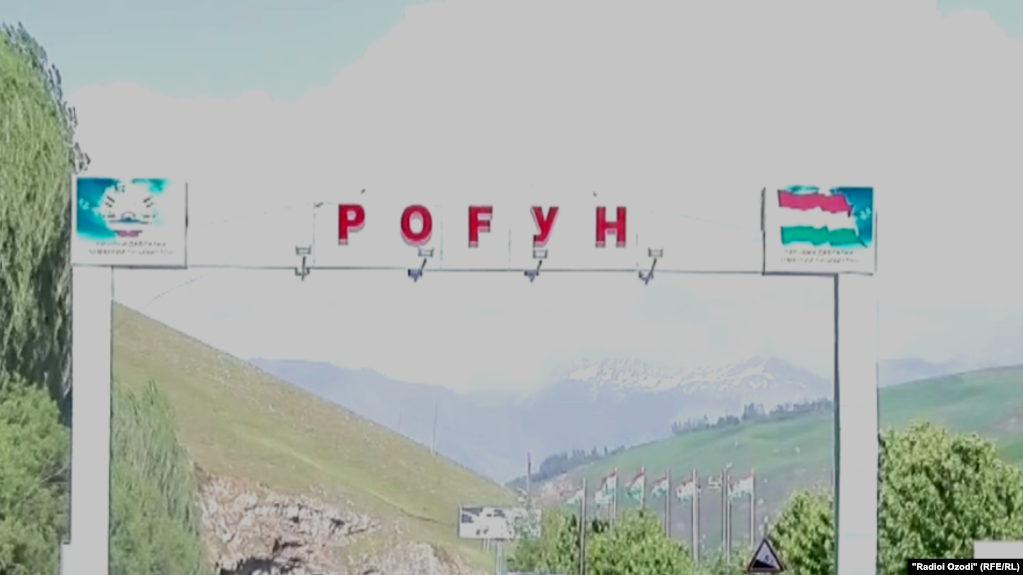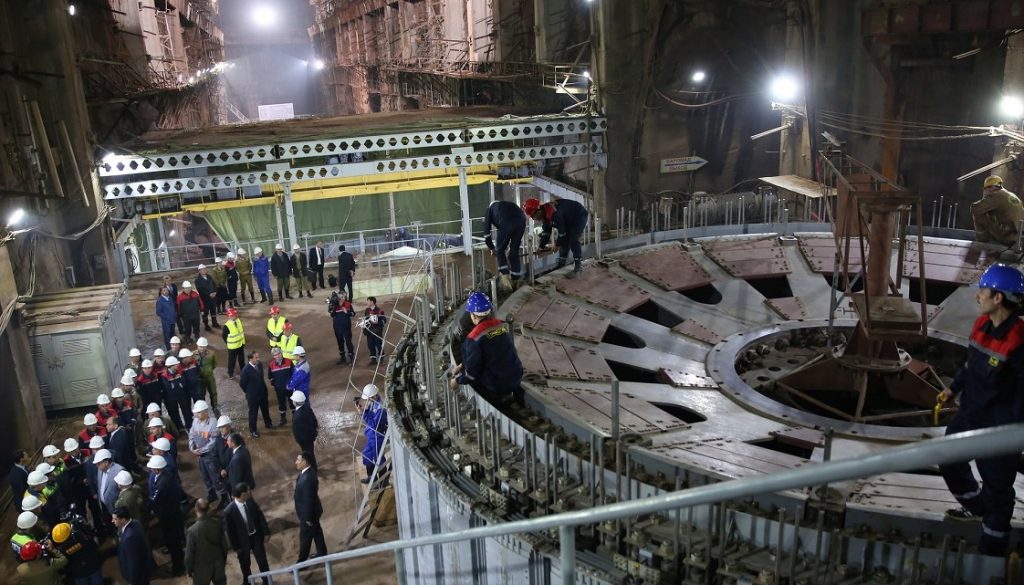The largest construction site in Tajikistan, the Rogun HPP, is experiencing financial and technical problems alongside the non-transparent financial processes. CABAR.asia expert doubts that the authorities will be able to complete construction without investors.
Follow us on LinkedIn

Over the past five months, the majority of employees of the Rogun HPP and some of its associated institutions, faced the non-payment of salaries.
The media reported about discontent of the Rogun Engineering College teachers, who have not been receiving their salaries for several months. The College’s management also noted that if the funds would be deposited to their account from the Rogun HPP side, then the salaries of teachers would be paid. Samariddin Yakubov, director of the Rogun Engineering College, noted that his employees had not been paid since this January. “The problem of lack of funds really exists in the College. As soon as the money reaches the Rogun HPP, it will reach us. Otherwise, we will have to wait”, Yakubov said on April 27 in an interview with Radio Ozodi. Rogun HPP Failure However, the lack of funds is not the only problem for the Rogun dam, which the Tajik authorities said to be “vital” construction for the country. The unexpected and mysterious first power plant unit shutdown, which presumably occurred in early March, caused many rumors. On May 16, the Prime Minister of Tajikistan Kokhir Rasulzoda visited the hydropower plant construction site and got acquainted with information on the water level, reservoir occupancy, dam and units condition. According to the press service of the Rogun HPP, the water level in the reservoir reached the required level at that time and after the dam inspection no other problems were identified. In their turn, representatives of the Italian company Salini impregilo SpA, the general contractor for the Rogun HPP construction, also stated that the water level reached 1020 meters above sea level, and the height of the water in the reservoir was 60 meters. According to this company, during the week, the first aggregate was launched in test mode again and there were no problems. According to this source’s verifications, the current volume and level of water allows to restart the first power plant unit. Earlier, it was planned to launch the second HPP unit this April. However, this did not happen; on the contrary, the first unit was stopped. Starting from the beginning of March to April 10, the country experienced severe limitation of electricity. Authorities do not report any information about the first unit shutdown. But there were rumors around the country that there were leaks in the Rogun dam. The dismissal of the chief engineer of the construction by the President on March 4 further accelerated the rumouring around the construction. The media reported that in March an accident had occurred at the Rogun HPP and the responsible executives were forced to dump the water from the reservoir. The officials responsible for this sphere did not confirm and did not disprove this news, but noted that “preventive and technical works” are being carried out at the HPP and this is precisely the reason for water evacuation and stopping the first unit.
The first unit of the Rogun HPP was launched in solemn ceremony on the President’s Day on November 16 last year, after the speeches of Emomali Rahmon and representatives of the country’s diplomatic corps. However, this unit worked for only three months, producing a little more than 90 million kWh of energy.
The emergence and size growth of the crack in the dam forced the construction management to drain the reservoir and repair it. Now, according to media, the problem has been solved with the assistance of foreign experts and the first unit is expected to be relaunched. However, none of the responsible persons answered why the first unit was stopped and why the second unit launch was interrupted. Nevertheless, during his visit to Moscow this April and meeting with representatives of the Tajik community in Russia, President Emomali Rahmon promised that the second unit of the Rogun HPP would be launched in September, on the eve of the Independence Day celebration. Taking into account the fact that it took two years to launch the first unit (from October 13, 2016 to November 2018), it remains unclear how it will be possible in a few months to collect enough water to launch the second unit in the reservoir that was emptied in April. Rogun HPP has 6 units. The height of the dam is 335 meters and it is capable of producing 17 billion kWh of electricity annually. With its commissioning, Tajikistan will fully resolve the issue of the electricity shortage and will be able to export it to other countries, including Afghanistan, Pakistan and Uzbekistan. Saifitdinov: Power Plant Management Cares More About Personal Interests However, local experts believe that the low-quality building materials usage that led to the accident, can lead to its repetition in future. Gulomiddin Saifitdinov, Tajikistan energetics expert, in an interview with the CABAR.asia analytical platform, says that low-quality cement, steel and other building materials are used in the Rogun HPP construction. “For the dam construction only high-quality tools and materials that meet international standards should be used. However, unfortunately, when ordering these materials for the power plant, the responsible persons are more concerned about their commercial interests and do not think about the consequences”, Saifitdinov said. He also added that the group that controls the quality of incoming materials simultaneously supplies them. However, the HPP administration in an interview with CABAR.asia denied this statement and asserted that all construction materials had passed preliminary laboratory tests. According to the source, there is no reason to believe that low-quality building materials are used in the HPP construction. How Much Money Was Spent on Rogun? The Tajik authorities have allocated more than 2.1 billion somoni (above $222 million) for the Rogun hydropower plant construction from the country’s budget for the current year. As President Emomali Rahmon stated in his speech to the Parliament in December 2018, since the Rogun hydropower plant construction began, 24 billion somoni was spent from all sources of financing (at the exchange rate during the time of publication – above $2.54 billion). Moreover, according to Rahmon, then it was planned to allocate for Rogun 4 billion somoni in 2019, that is, twice as the current amount. “Since the Rogun HPP construction began, 24 billion somoni from all sources of financing have been spent, 3.9 billion somoni – only in 2018, and in 2019 it is planned to allocate almost 4 billion somoni, which will allow [to carry out] the timely launch of the second unit of the largest HPP in the region”, said President Rahmon. Let us note that in 2010, the authorities raised $185 million through a widely advertised campaign of selling shares to the public, companies and institutions. Moreover, the enforced sale of shares took place amid of the fact that over 60% of the population lived below the official poverty line. Then, the World Bank recommended the authorities of Tajikistan to refrain from continuing the campaign of enforced sale of shares. In 2017 and 2018, the authorities were able to raise another $500 million for the Rogun hydropower plant construction by selling Eurobonds on European markets.
At the same time, the authorities and the Italian company Salini impregilo SpA, the general contractor for the HPP construction, estimate the total cost of the project at $3.9 billion.
Thus, most of the planned budget, $2.5 billion, has already been spent. In total it is necessary to launch 6 units of hydropower plant. So far, only one is actually launched. And it is not even functioning now. Sobirov: Commission for Funds Control of the Rogun HPP Held a 15-Minutes Meeting Despite the optimistic statements by the heads of the HPP and the energy sector, local experts are talking about major problems at the facility, in particular, about the problem of the designated use of allocated funds. Illegal trafficking of HPP materials such as fuel and lubricant materials, tires, wheels and other parts, registration violations, lack of transparency, fraud schemes in the finances, are everyday problems of hydroelectric power plant. According to this group of experts, the spending of budget funds and loans attracted by the state for construction is especially non-transparent.
Masud Sobirov, a Tajik economist and a member of the Commission for Shares and Funds Control at the HPP, told CABAR.asia that, till now, he has not heard a report from the authorities about spendings on HPP.

The resettlement process of these villages inhabitants is planned to be completed by 2040. During this time, 42 thousand people from 40 villages will be relocated to other places. The state has provided 200 million somoni ($20 million) for the resettlement of these villagers.
In the past, Human Rights Watch organization criticized the government for violating human rights in the process of resettling people to a new place. This organization reported that despite the fact that the Government of Tajikistan declares compliance with international standards when relocating citizens, families do not receive full compensation for the new housing construction. Rahimjon Khaknazarov, one of the residents of the Chinor village in the Nurobod district, who is preparing for the relocation, says that he is ready to solve all the problems of resettlement hoping for a better tomorrow. According to him, he is ready to give up his real estate for this: garden, land and house. But Khaknazarov’s neighbor doubts that the plans for the HPP construction will be implemented by the authorities on time. People who are forced to leave their houses inhabited by all previous generations say that they are ready to start life anew if power cutoffs in Tajikistan will really be left behind like a bad dream… World Bank Recommendations At the same time, Tajikistan requested financial assistance from the World Bank to continue the HPP construction. However, the World Bank, responding to this request, noted the vagueness of the term “exclusive state property” mentioned in the Government of Tajikistan’s resolution on the Rogun hydropower plant (2009) and recommended revising this facility construction program and providing for the possibility of private sector participation. Masud Sobirov, Tajik economist, is also confident that the Government of Tajikistan does not have sufficient financial resources to complete construction works. “It is possible that the first and second units will be launched, but the continuation of construction without attracting foreign investment and investors will last for many years and will be a heavy burden on the state budget”, says Sobirov.This article was prepared as part of the Giving Voice, Driving Change – from the Borderland to the Steppes Project implemented with the financial support of the Foreign Ministry of Norway. The opinions expressed in the article do not reflect the position of the editorial or donor.

